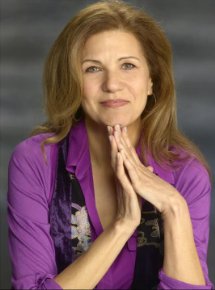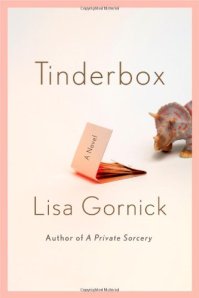Lisa Gornick’s Tinderbox is a powerfully written exploration of one family in a state of crisis. Her training and experience as a psychologist and psychoanalyst shows through in the richness and realism of her characterizations. The novel also benefits from a compelling multi-level plot and an intriguing structure. You can read my recent review here.
Can you tell me about your background as a writer (e.g., when you started, your education, writing experiences, etc.)? What led you from psychology and psychoanalysis to fiction?
I actually started as a writer, and then became a psychologist and ultimately a psychoanalyst. Like most writers, I was first a passionate reader — one of those nose-in-a-book kids. By high school, I’d begun my own scribbling: poems that in my twenties morphed into stories. Becoming a therapist and ultimately a psychoanalyst was an organic outgrowth of my love of language and character-driven novels. Over the years, I’ve written about Freud’s relationship with creative writing and creative writers and the links between “novelizing” and “analyzing,” including the connection between free association and the literary imagination, pulse points in fiction and a treatment, and the centrality in both endeavors of the story behind the story.
I would imagine that this background would come in handy in creating complex, realistic characters. The characters in Tinderbox all had some kind of quirk or burden, all of which seemed realistic to me. People are full of contradictions, complexities, character “flaws” and secrets. Do you get a lot of ideas from your therapy practice?
I have a rigid rule about writing about patients: verboten in any form, clinical or fiction. That said, my understanding of how we become who we are and how stories unfold is strongly informed by my psychoanalytic training and experience.
What made you feel that you had to tell this story? What were your goals/artistic objectives in writing Tinderbox, beyond telling a compelling story?
Tinderbox began with a true story that got under my skin about a nanny who fell apart when she came to work for a family whose loving attention to their child stimulated her own buried longings for a mothering she’d never had. The story (whose details I entirely altered) dovetailed with an interest in one of the occupational hazards for therapists, who are often a magnet for revelations by people encountered outside our offices — a situation in which everyday kindly intentions of being a sympathetic ear need to be tempered with prudence about what is best directed into a treatment. While these ideas were percolating, I spent some weeks in Montana and Idaho when terrifying wildfires were blazing, a contributing factor, I learned, having been the Smokey Bear policy of preventing all fires, which can lead to overgrown underbrush that sets the stage for out-of-control conflagrations. These situations came together in what is a central theme of the novel: a tragedy of good intentions.
What was the greatest challenge in writing Tinderbox?
The greatest challenge of writing Tinderbox was figuring out the structure. I am a great admirer of old-fashioned sprawling novels that move seamlessly in and out of various characters’ heads with a relaxed capaciousness, and I didn’t want to be constricted by what seems to me to be the now overused schema of alternating points of view by chapter. Rather, I wanted the story to be preeminent: to narrate each scene from the point of view that makes most sense for both that moment and the larger unfolding of the various elements of the novel. The image I had was that the narrative is like a baton passed from character to character — though I did limit the number of characters who have access to the baton, in part to enhance the mystery and suspense.
The second major structural challenge concerned how to handle time. I’ve heard it said that our personal narratives begin with the memories of our grandparents, and indeed the story told in Tinderbox stretches back several generations. At the same time, I wanted the novel to have a tight front story with a clear beginning, middle, and end. The aim was to have the scenes in the past have the same vibrancy as the scenes in the present (i.e. to avoid the feeling of the flashback) while simultaneously maintaining a strong driving sense of the contemporary story moving forward. Novels, like nearly every important undertaking, contain many opposing forces, and insight, hard work, and a good dose of luck are required to achieve a balance.
Readers might wonder whether you have actually been to the exotic locales in the book like Peru and Morocco. From your detailed descriptions and the strong sense of place you create in the Morocco scenes, it certainly seems like you’ve been there.
I have spent time in both Morocco and Peru. I couldn’t have written the scenes that take place in Essaouira, the wind-swept city where Rachida grew up, without having been there first. As for Iquitos, the nanny Eva’s home, I didn’t visit there until I’d written several drafts of the novel. Thinking about it now, that was for the best. Eva is the one major character whose point of view is never shared, so her home is understood only through others’ fantasies about it — most particularly, through Adam, the father of the child Eva cares for, who has been obsessed with the place since first seeing Werner Herzog’s film Fitzcarraldo, which is set there.
How did you become interested in Sephardic Jews and their migrations? Have you found that readers are particularly intrigued by the subplot about Moroccan Jews in Peru? Most people have no idea there were (and are) Jews in Latin America (and that many of them were and are Crypto-Jews who hide their identity in a very Catholic part of the world), and they usually aren’t aware of their presence historically in countries like Morocco, Iraq, and Iran.
Learning about the Jews of Iquitos was an uncanny discovery for me. When I first began the novel, I’d already decided that Eva was from Iquitos — which, like Adam, I knew about from Herzog’s Fitzcarraldo and Les Blank’s documentary Burden of Dreams, about the parallel process between Herzog’s epic making of the movie and his character Fitzcarraldo’s maniacal project. I’d already conceived of Adam’s wife, Rachida, a Moroccan Jewish doctor from Essaouira, whose now decimated but once powerful Jewish community I knew about from my travels. Then, one day when I was reading about Iquitos, I stumbled upon a reference to a small Jewish community in Iquitos. That seemed strange: a Jewish community in a landlocked city, accessible only by boat or air, in the middle of the jungle? My curiosity piqued, I began to research further and — my heart nearly stopped. The Jews of Iquitos, I learned, were the descendants of Moroccan Jewish rubber traders, many mere boys of 19 or 20, who’d come to the perilous Amazon during the rubber boom of the late 1800’s and then peremptorily departed when the boom went bust in the early 1900’s, leaving behind their common-law Indian wives and offspring. In other words, there might be an historical link between my characters Rachida and Eva, whom I’d independently imagined and never thought of having a connection beyond employer and employee.
Adam’s obsession with pornography ties in with the problems caused in some marriages by the limitless supply of porn on the Internet. Did you (do you) see a lot of this porn obsession in your work as a therapist? What does it signify generally and for Adam specifically?
You don’t have to be a therapist to know that porn is ubiquitous in our culture. It’s virtually impossible for preteens not to stumble upon it, and it has a huge impact on men’s lives. For Adam, there is a very specific meaning to the images he seeks — and they are key to understanding his psychic life, but his use of porn is also terribly destructive for him and for his family. Because he’s a screenwriter and movies are sacred to him, he’s horrified at the idea of contaminating his work with porn viewed on a screen, so unlike most contemporary porn addicts, he looks only at porn in magazines.
What are your favorite books or the ones that most influenced you?
For Tinderbox, there was a specific set of novels that I studied — literally outlined to understand how they were put together. This group of novels included Peter Carey’s His Illegal Self, Alice McDermott’s After This, and Kazuo Ishiguro’s The Remains of the Day. In everything I write, I have been deeply influenced by Alice Munro: the economical way she conveys an entire life within a tight narrative; her original sentences, devoid of writerly showiness, that convey the way we think; her acceptance of the coexistence of pettiness and largesse in the human heart.
Several drafts into Tinderbox, I read for the first time Anna Karenina (the Pevear and Volokhonsky translation). I was stunned by how contemporary the novel feels and how gripping it is despite its enormous cast of characters and sociological, philosophical and political ambitions. The novel’s accessibility, it seems to me, is in part due to the structure of bite-sized sections, each of which can easily be read in a single sitting, within longer parts. Inspired by Tolstoy, I revamped Tinderbox, throwing out the chapters, and reorganizing it into four parts, each, a la Anna, with short numbered sections.
What are you working on now, and when can we expect to see it in bookstores?
I have a collection of linked short stories — a novel in fragments — titled Louisa Meets Bear that centers on a star-crossed affair between Louisa, the artistic and sexually-adventurous daughter of a San Francisco geneticist, and Bear, the passionate but explosive son of a Cincinnati plumber, upcoming, also with Sarah Crichton Books/ Farrar, Straus and Giroux, in June of 2015. And, I’m finishing up a new novel, tentatively titled The Peacock Feast, that opens in 1916 with Louis C. Tiffany, the genius glass artist, torpedoing the breakwater in front of his phantasmagorical Oyster Bay mansion, with its daffodil columns and blue-tiled minaret, rather than allowing the town to reclaim what he viewed as his beach for public bathing.


As always you seem to have so many interesting author interviews and book reviews on your site. Thanks for this. Enjoyed reading it.
LikeLike